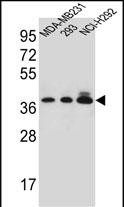TAS2R1 Antibody (C-term)
Affinity Purified Rabbit Polyclonal Antibody (Pab)
- SPECIFICATION
- CITATIONS
- PROTOCOLS
- BACKGROUND

Application
| WB, E |
|---|---|
| Primary Accession | Q9NYW7 |
| Other Accession | NP_062545.1 |
| Reactivity | Human |
| Host | Rabbit |
| Clonality | Polyclonal |
| Isotype | Rabbit IgG |
| Calculated MW | 34333 Da |
| Antigen Region | 267-296 aa |
| Gene ID | 50834 |
|---|---|
| Other Names | Taste receptor type 2 member 1, T2R1, Taste receptor family B member 7, TRB7, TAS2R1 |
| Target/Specificity | This TAS2R1 antibody is generated from rabbits immunized with a KLH conjugated synthetic peptide between 267-296 amino acids from the C-terminal region of human TAS2R1. |
| Dilution | WB~~1:1000 E~~Use at an assay dependent concentration. |
| Format | Purified polyclonal antibody supplied in PBS with 0.09% (W/V) sodium azide. This antibody is purified through a protein A column, followed by peptide affinity purification. |
| Storage | Maintain refrigerated at 2-8°C for up to 2 weeks. For long term storage store at -20°C in small aliquots to prevent freeze-thaw cycles. |
| Precautions | TAS2R1 Antibody (C-term) is for research use only and not for use in diagnostic or therapeutic procedures. |
| Name | TAS2R1 |
|---|---|
| Function | Receptor that may play a role in the perception of bitterness and is gustducin-linked. May play a role in sensing the chemical composition of the gastrointestinal content. The activity of this receptor may stimulate alpha gustducin, mediate PLC-beta-2 activation and lead to the gating of TRPM5. |
| Cellular Location | Membrane; Multi-pass membrane protein. |
| Tissue Location | Expressed in subsets of taste receptor cells of the tongue and palate epithelium and exclusively in gustducin-positive cells |

Thousands of laboratories across the world have published research that depended on the performance of antibodies from Abcepta to advance their research. Check out links to articles that cite our products in major peer-reviewed journals, organized by research category.
info@abcepta.com, and receive a free "I Love Antibodies" mug.
Provided below are standard protocols that you may find useful for product applications.
Background
This gene encodes a member of a family of candidate taste receptors that are members of the G protein-coupled receptor superfamily and that are specifically expressed by taste receptor cells of the tongue and palate epithelia. This intronless taste receptor gene encodes a 7-transmembrane receptor protein, functioning as a bitter taste receptor. This gene is mapped to chromosome 5p15, the location of a genetic locus (PROP) that controls the detection of the bitter compound 6-n-propyl-2-thiouracil.
References
Upadhyaya, J., et al. Biochem. Biophys. Res. Commun. 398(2):331-335(2010)
Weiss, L.A., et al. Nature 461(7265):802-808(2009)
Go, Y., et al. Genetics 170(1):313-326(2005)
Fischer, A., et al. Mol. Biol. Evol. 22(3):432-436(2005)
Zhang, Y., et al. Cell 112(3):293-301(2003)
If you have used an Abcepta product and would like to share how it has performed, please click on the "Submit Review" button and provide the requested information. Our staff will examine and post your review and contact you if needed.
If you have any additional inquiries please email technical services at tech@abcepta.com.













 Foundational characteristics of cancer include proliferation, angiogenesis, migration, evasion of apoptosis, and cellular immortality. Find key markers for these cellular processes and antibodies to detect them.
Foundational characteristics of cancer include proliferation, angiogenesis, migration, evasion of apoptosis, and cellular immortality. Find key markers for these cellular processes and antibodies to detect them. The SUMOplot™ Analysis Program predicts and scores sumoylation sites in your protein. SUMOylation is a post-translational modification involved in various cellular processes, such as nuclear-cytosolic transport, transcriptional regulation, apoptosis, protein stability, response to stress, and progression through the cell cycle.
The SUMOplot™ Analysis Program predicts and scores sumoylation sites in your protein. SUMOylation is a post-translational modification involved in various cellular processes, such as nuclear-cytosolic transport, transcriptional regulation, apoptosis, protein stability, response to stress, and progression through the cell cycle. The Autophagy Receptor Motif Plotter predicts and scores autophagy receptor binding sites in your protein. Identifying proteins connected to this pathway is critical to understanding the role of autophagy in physiological as well as pathological processes such as development, differentiation, neurodegenerative diseases, stress, infection, and cancer.
The Autophagy Receptor Motif Plotter predicts and scores autophagy receptor binding sites in your protein. Identifying proteins connected to this pathway is critical to understanding the role of autophagy in physiological as well as pathological processes such as development, differentiation, neurodegenerative diseases, stress, infection, and cancer.



